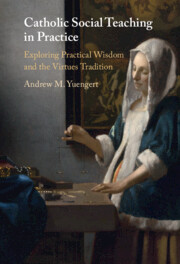67 results
Chapter 7 - Capturing the Complexity of Collaborations in Varied Settings
- from Part III - A New Theory and Method for Assessing Development via Collaborative Competence
-
- Book:
- Developing Together
- Published online:
- 07 May 2024
- Print publication:
- 09 May 2024, pp 113-136
-
- Chapter
- Export citation
Protecting the cultural property of religious communities during war: The Church of Sweden and total defense planning
-
- Journal:
- International Journal of Cultural Property , First View
- Published online by Cambridge University Press:
- 20 March 2024, pp. 1-21
-
- Article
-
- You have access
- Open access
- HTML
- Export citation
10 - American Pragmatism, Democratic Ethics, and Education
- from Part I - Traditions in Ethics and Education
-
-
- Book:
- The Cambridge Handbook of Ethics and Education
- Published online:
- 07 March 2024
- Print publication:
- 14 March 2024, pp 186-212
-
- Chapter
- Export citation
Critical Reflections on the Role of the Canon in New Testament Scholarship
-
- Journal:
- New Testament Studies / Volume 70 / Issue 1 / January 2024
- Published online by Cambridge University Press:
- 01 February 2024, pp. 111-124
- Print publication:
- January 2024
-
- Article
-
- You have access
- Open access
- HTML
- Export citation
6 - Rorty, Irony, and Neoliberalism
- from Part III - Irony’s Impact
-
-
- Book:
- The Cambridge Handbook of Irony and Thought
- Published online:
- 20 December 2023
- Print publication:
- 07 December 2023, pp 96-111
-
- Chapter
- Export citation
13 - Orchestrating Chaos
- from Part IV - Literary Genres
-
-
- Book:
- Jazz and American Culture
- Published online:
- 09 November 2023
- Print publication:
- 30 November 2023, pp 203-218
-
- Chapter
- Export citation
The necessity of multi-disciplinary scholarship for finance: On Ayache and Roffe
-
- Journal:
- Finance and Society / Volume 2 / Issue 2 / 2016
- Published online by Cambridge University Press:
- 09 November 2023, pp. 189-204
-
- Article
-
- You have access
- Open access
- Export citation
Response to Johnson: A random sample versus the radical event
-
- Journal:
- Finance and Society / Volume 2 / Issue 2 / 2016
- Published online by Cambridge University Press:
- 09 November 2023, pp. 205-216
-
- Article
-
- You have access
- Open access
- Export citation
Chapter 28 - Fatal Necessity
- from Part IV - Laudianism and Predestination
-
- Book:
- On Laudianism
- Published online:
- 05 October 2023
- Print publication:
- 19 October 2023, pp 366-375
-
- Chapter
- Export citation
13 - Advancing Research on Frontline Crisis Response
-
- Book:
- Frontline Crisis Response
- Published online:
- 28 September 2023
- Print publication:
- 12 October 2023, pp 208-220
-
- Chapter
- Export citation
The Necessity of God: Modern Theology and the Church’s Witness
-
- Journal:
- Journal of Anglican Studies , First View
- Published online by Cambridge University Press:
- 23 August 2023, pp. 1-15
-
- Article
- Export citation
Chapter 8 - Organisms as “Natural Ends” and Reflective Judgment’s “Image” of Externalized Freedom
- from Part III - Teleological Judgment and the “Moral Image”
-
- Book:
- The <i>Critique of Judgment</i> and the Unity of Kant's Critical System
- Published online:
- 15 August 2023
- Print publication:
- 10 August 2023, pp 206-234
-
- Chapter
- Export citation
2 - Aspirations, Obligations, and Imagination in Family Migration
-
- Book:
- Relative Distance
- Published online:
- 22 June 2023
- Print publication:
- 06 July 2023, pp 55-78
-
- Chapter
- Export citation
12 - After Historicism: The Politics of Time and History in Twentieth-Century Germany
-
-
- Book:
- Time, History, and Political Thought
- Published online:
- 08 June 2023
- Print publication:
- 22 June 2023, pp 259-284
-
- Chapter
- Export citation
Introduction: Time, History, and Political Thought
-
-
- Book:
- Time, History, and Political Thought
- Published online:
- 08 June 2023
- Print publication:
- 22 June 2023, pp 1-35
-
- Chapter
- Export citation
5 - Politic History
-
-
- Book:
- Time, History, and Political Thought
- Published online:
- 08 June 2023
- Print publication:
- 22 June 2023, pp 102-135
-
- Chapter
- Export citation

Catholic Social Teaching in Practice
- Exploring Practical Wisdom and the Virtues Tradition
-
- Published online:
- 03 June 2023
- Print publication:
- 15 June 2023
Chapter 5 - The Non-truth of Mechanism
-
- Book:
- True Purposes in Hegel's Logic
- Published online:
- 16 May 2023
- Print publication:
- 27 April 2023, pp 79-110
-
- Chapter
- Export citation
A hard to read font reduces the causality bias
-
- Journal:
- Judgment and Decision Making / Volume 14 / Issue 5 / September 2019
- Published online by Cambridge University Press:
- 01 January 2023, pp. 547-554
-
- Article
-
- You have access
- Open access
- HTML
- Export citation
2 - Coffee, Cigarettes, and International Judicial Practices
-
- Book:
- The Everyday Makers of International Law
- Published online:
- 03 November 2022
- Print publication:
- 17 November 2022, pp 22-53
-
- Chapter
- Export citation



